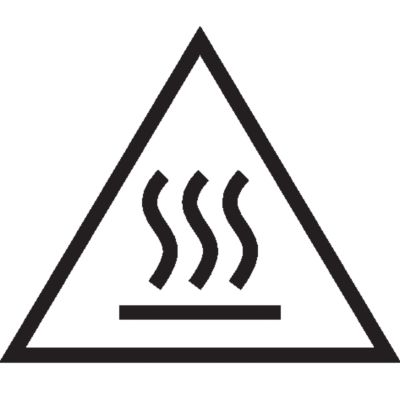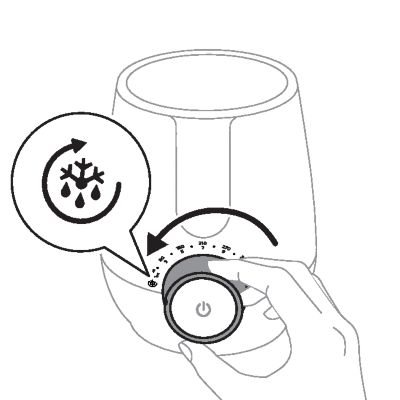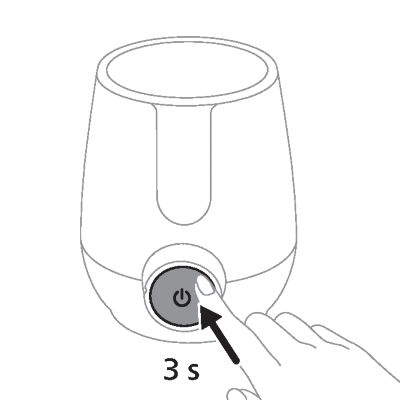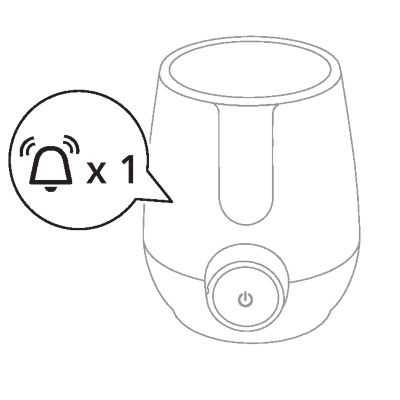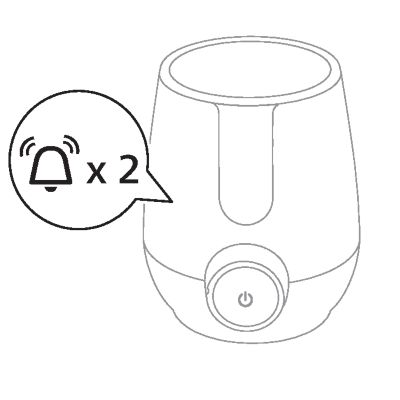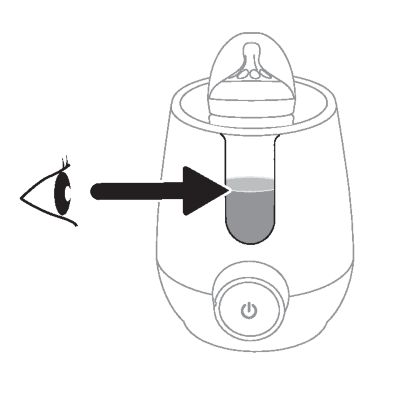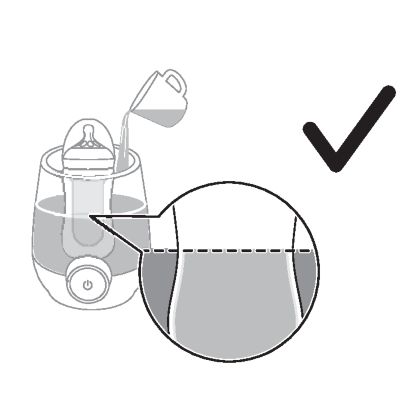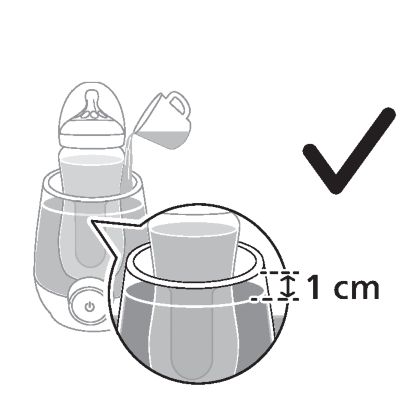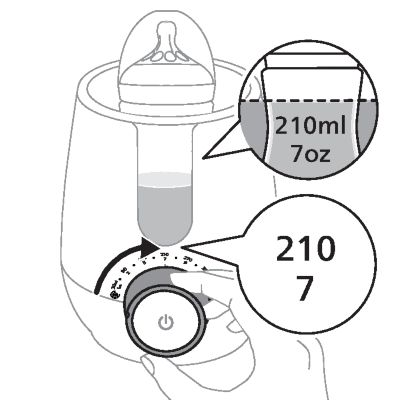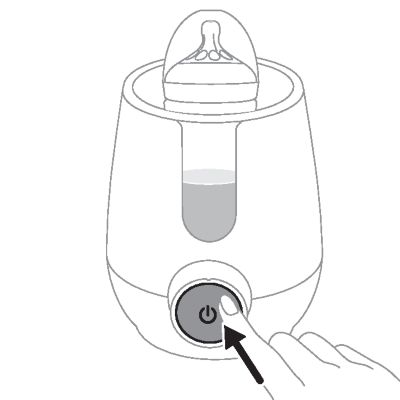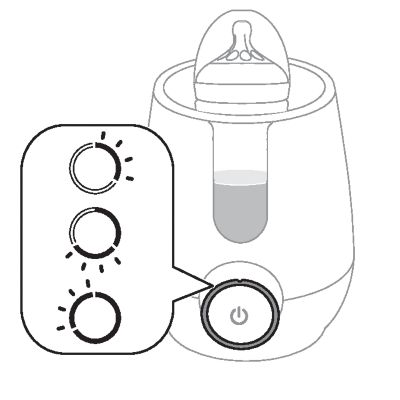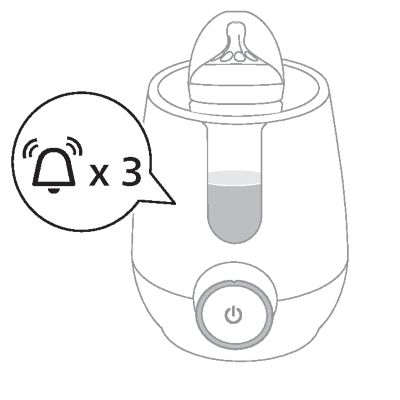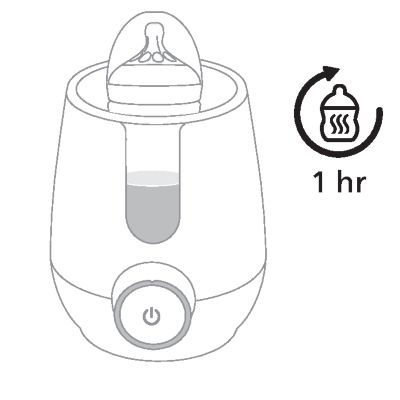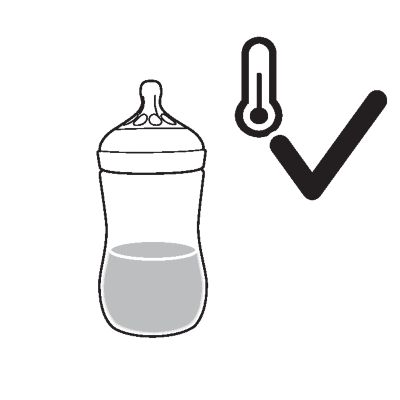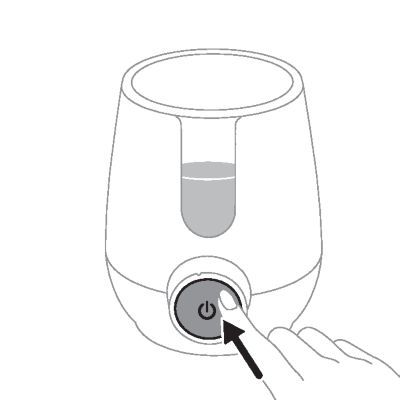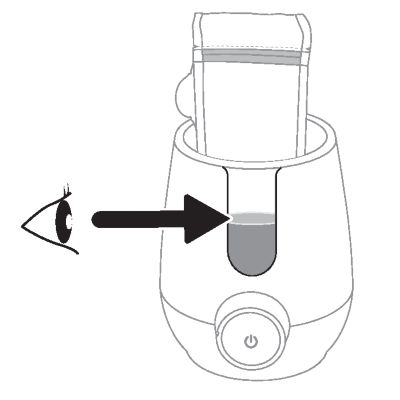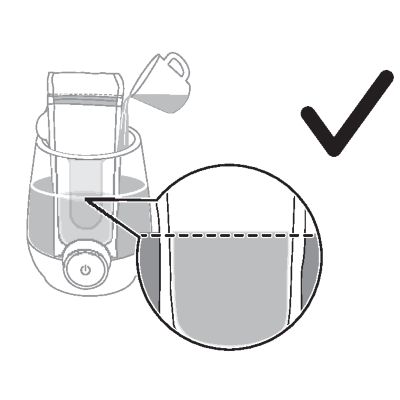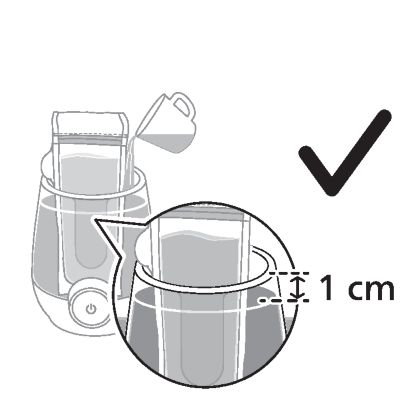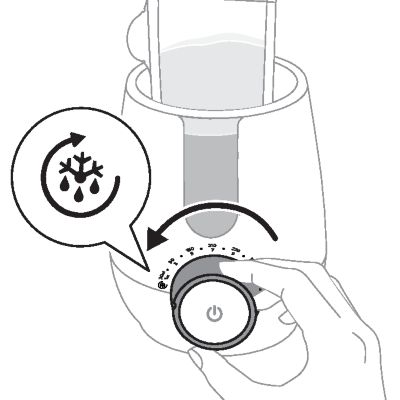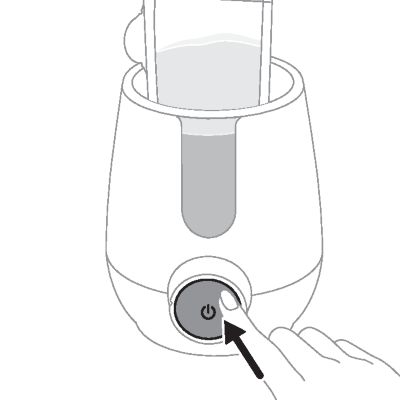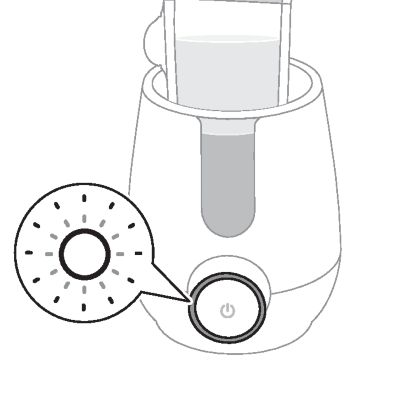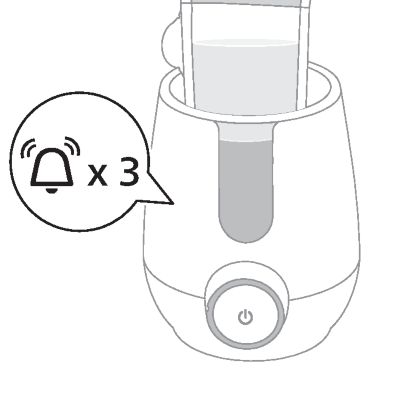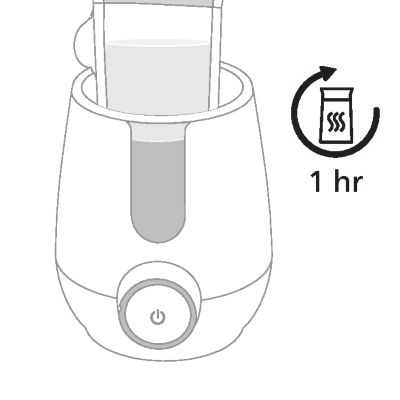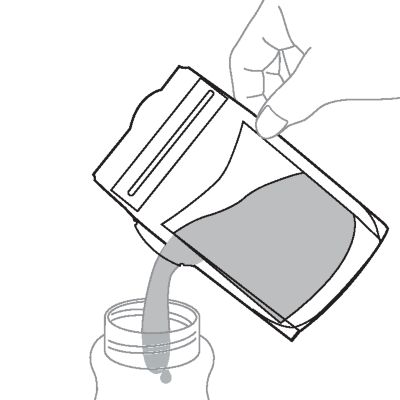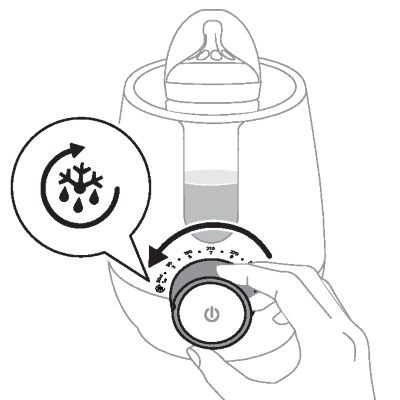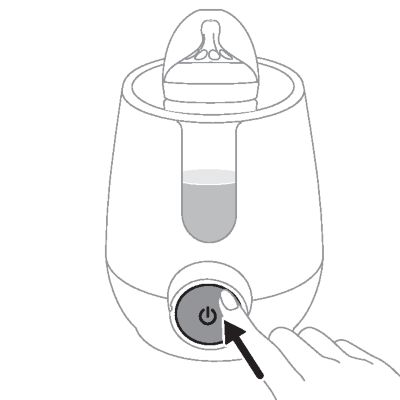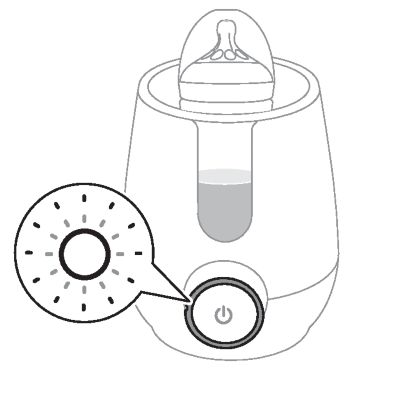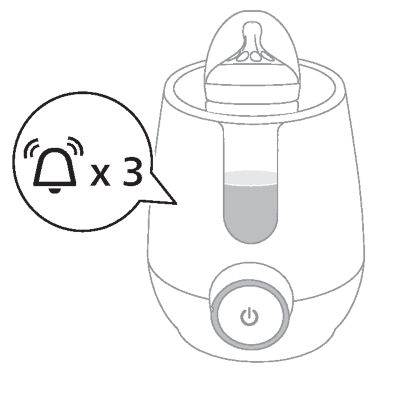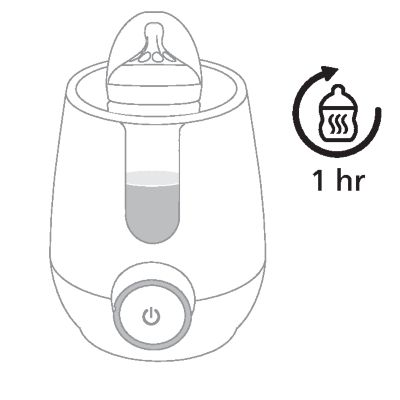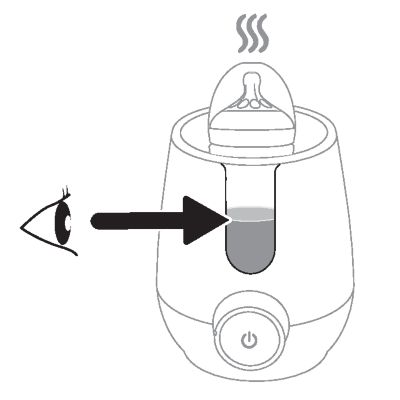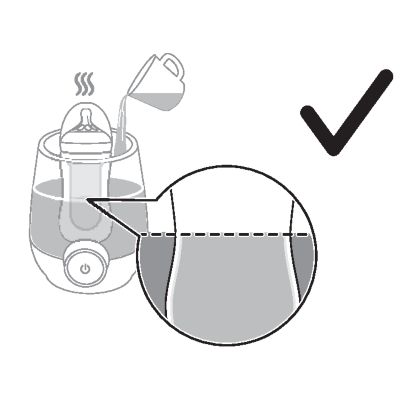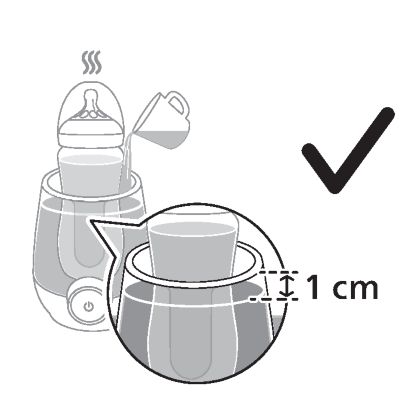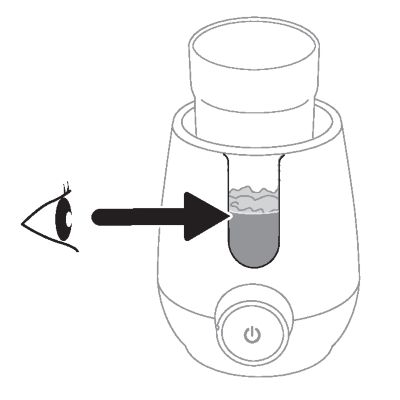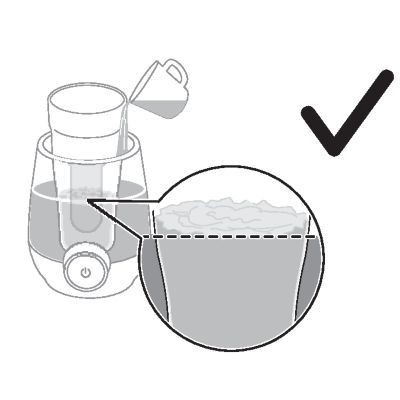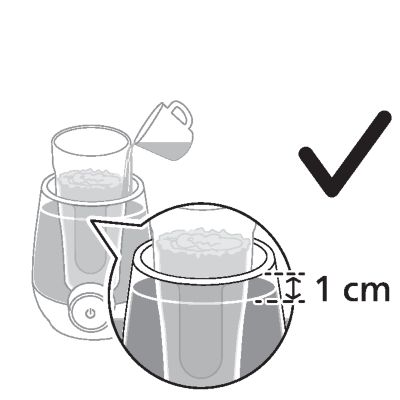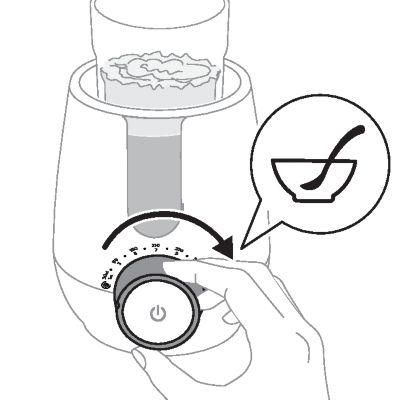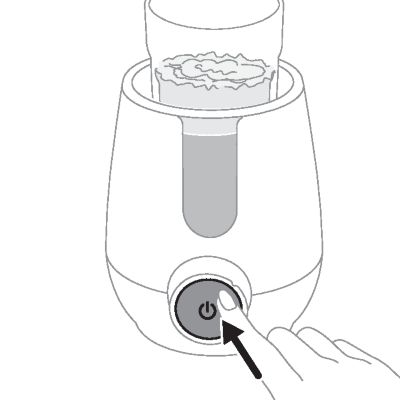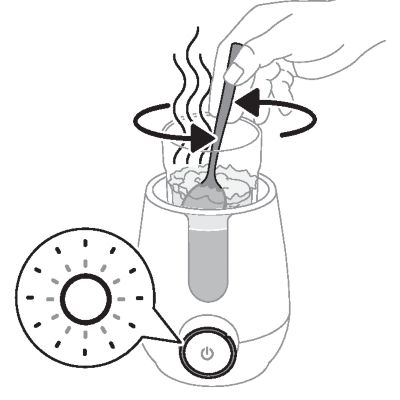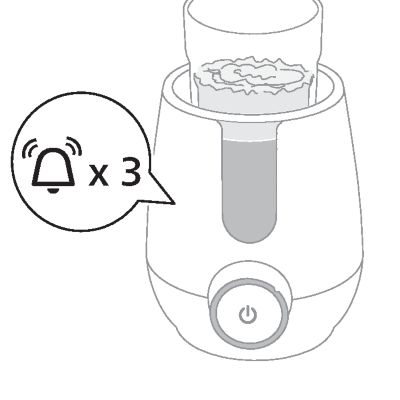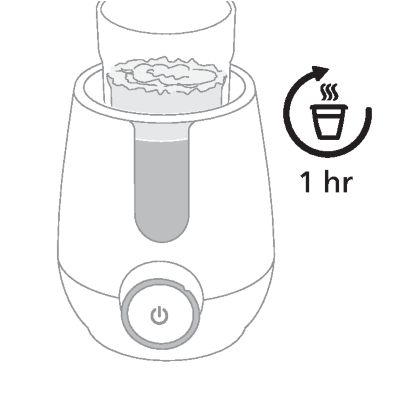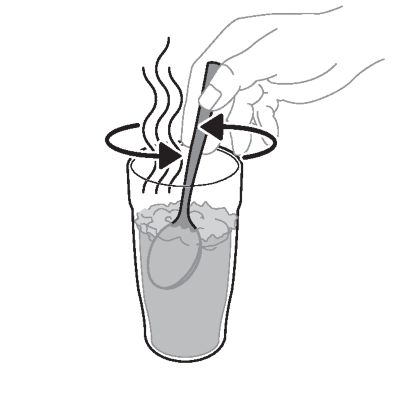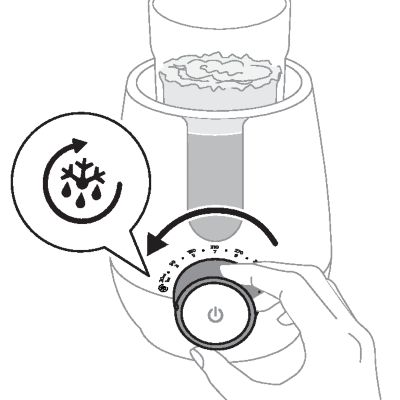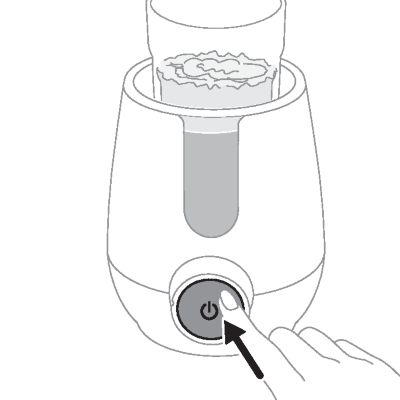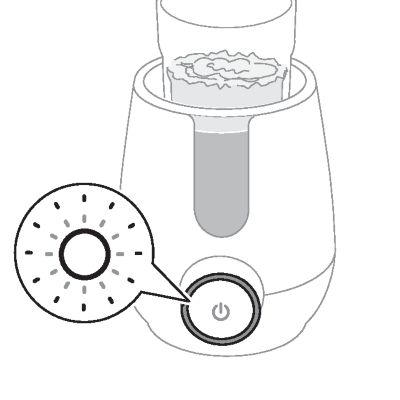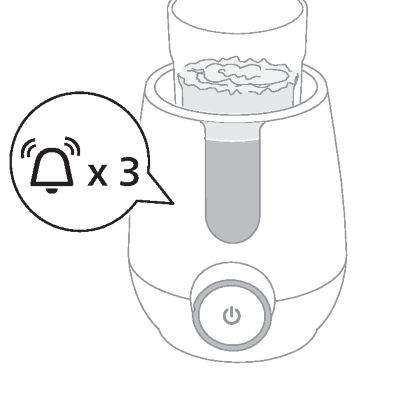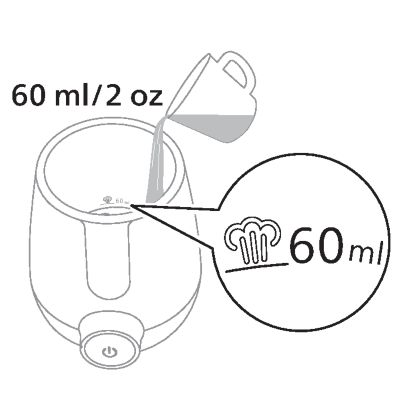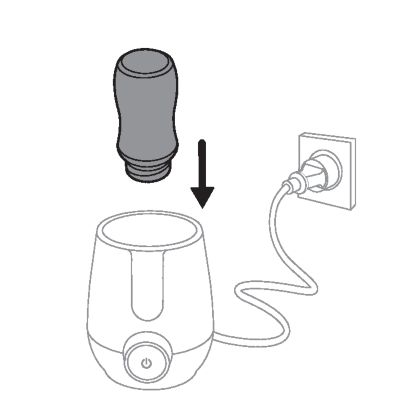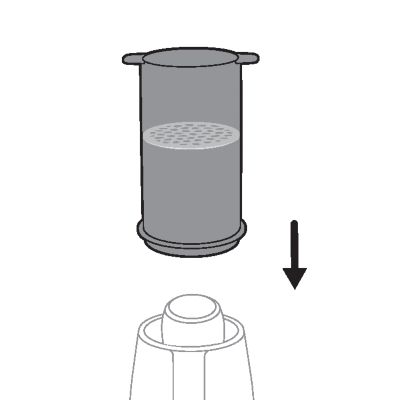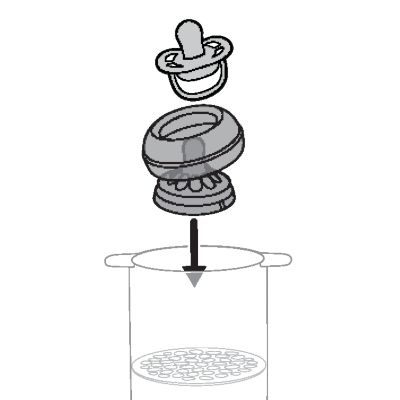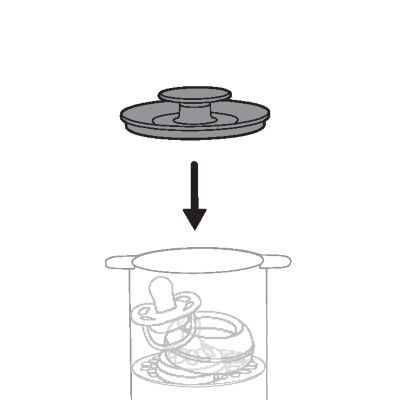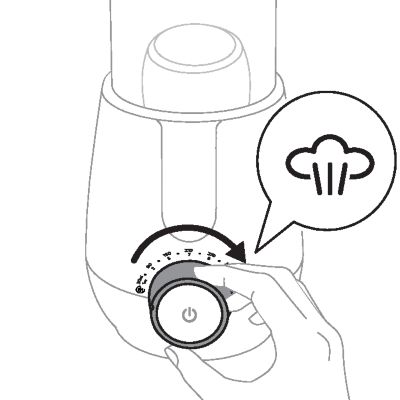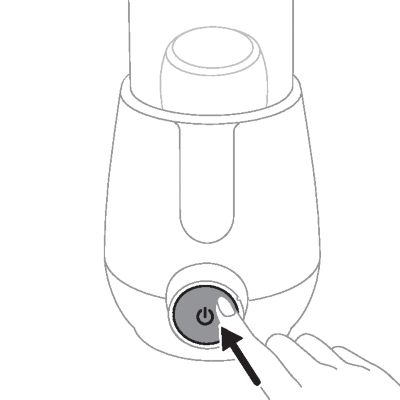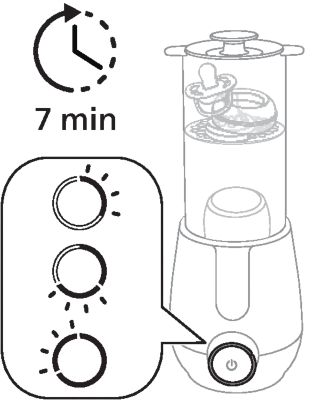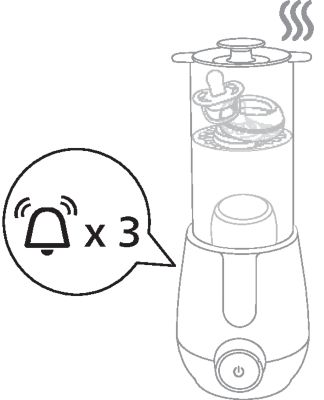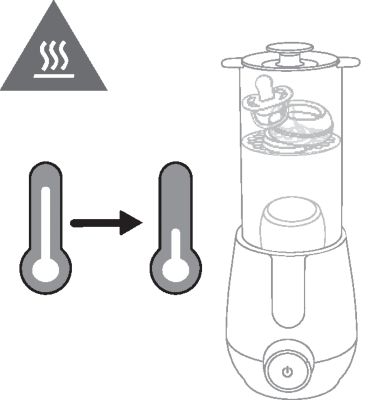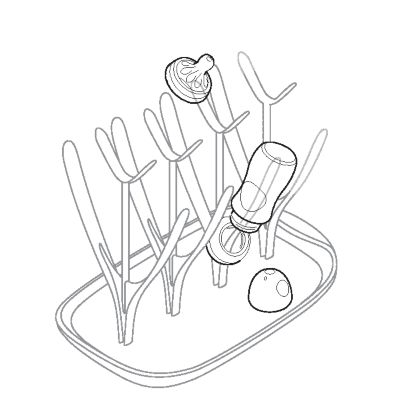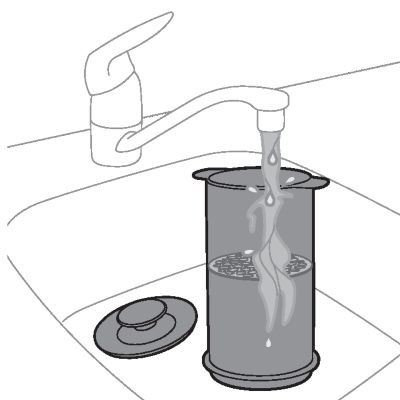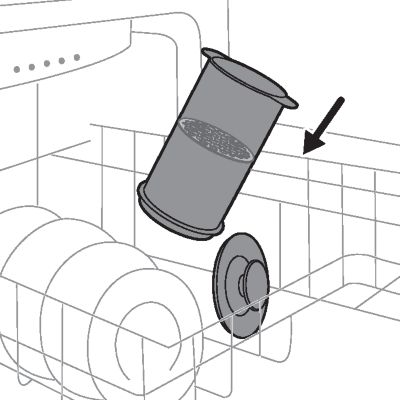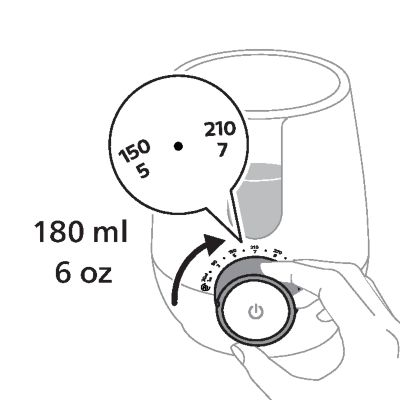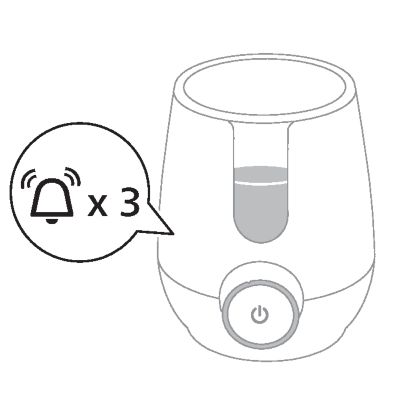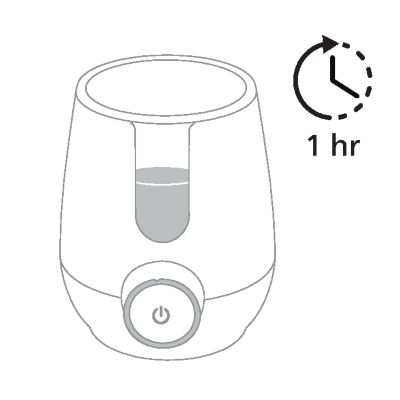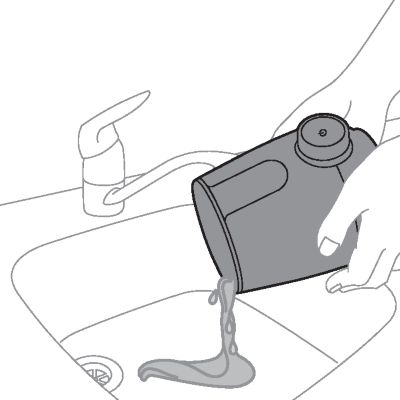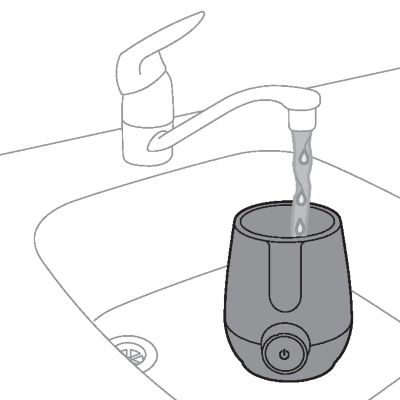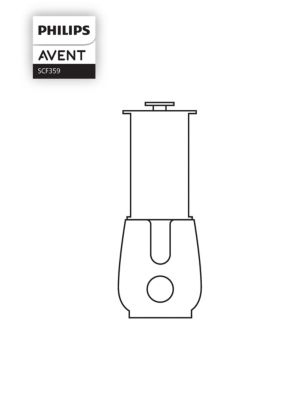
Congratulations on your purchase and welcome to Philips Avent! To fully benefit from the support that Philips Avent offers, register your product at www.philips.com/welcome.
To learn more about your new Philips Avent Premium 2-in-1 Warmer & Sterilizer, click here.
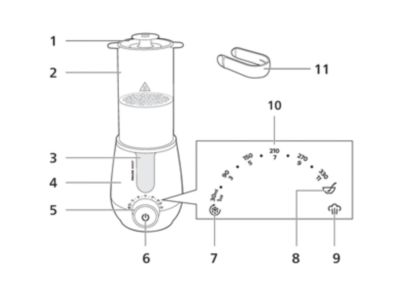
| 1 | Lid | 6 | Power button |
| 2 | Sterilization attachment | 7 | Keep warm/defrost setting |
| 3 | Window | 8 | Baby food warming setting |
| 4 | Base | 9 | Sterilizing setting |
| 5 | Progress indicator | 10 | Milk volume setting |
| 11 | Tongs* |
*Available with SCF359/20, SCF359/21 only.
Read this important information carefully before you use the appliance and save it for future reference.
Warning
- To protect against electrical shock, do not immerse cords, plugs, or appliance in water or other liquid.
- Failure to follow the descaling instructions may cause irreparable damage.
- Never disassemble the base to avoid the risk of electric shock.
- A short power-supply cord is provided to reduce risk of entanglement or tripping over a longer cord. Longer extension cords are available and may be used if care is exercised in their use. If a long extension cord is used, the marked electrical rating of the extension cord must be at least as great as the electrical rating of the appliance, and the longer cord should be arranged so that it will not drape over the countertop or tabletop where it can be tripped over or pulled on by children. The extension cord shall be a grounding-type 3-wire cord.
- Only use the appliance indoors.
- Do not let the power cord hang over the edge of a table or worktop and do not let it touch hot surfaces.
- Store excess cord using the cord wrap feature in the base of the appliance.
- Only connect the appliance to a grounded wall socket. Always make sure that the plug is inserted into the wall socket properly.
- Before using the appliance, check whether the voltage indicated on the bottom corresponds to the local voltage.
- If you need to use an extension cord, make sure it is a grounded extension cord with a rating of at least 13 amperes.
- Do not operate any appliance with a damaged cord or plug or after the appliance malfunctions or has been damaged in any manner. Return the appliance to the nearest authorized service facility for examination, repair, or adjustment.
- Do not place the appliance on or near a hot gas or electric burner, or in a heated oven.
- This appliance can be used by persons with reduced physical, sensory or mental capabilities or lack of experience and knowledge if they have been given supervision or instruction concerning use of the appliance in a safe way and understand the hazards involved.
- This appliance shall not be used by children. Keep the appliance and its cord out of the reach of children. Children should be supervised to ensure they do not play with the appliance.
- Do not spill water on the power plug.
- Only use the appliance as described in the user manual to avoid injury due to misuse.
- Do not preheat the appliance.
- When warming milk, always place a fully assembled bottle with cap in the bottle warmer before you add water.
- Make sure you add water before you switch on the bottle warmer.
- Hot water can cause serious burns. Be careful when the appliance contains hot water.
-
- The accessible surfaces of the appliance may become hot during use and are subject to residual heat after use.
- Do not move the appliance when it contains hot water.
- When the food or milk has reached the required temperature, remove the bottle or container from the bottle warmer. If you leave food or milk in the bottle warmer, the temperature of the food or milk increases.
- There are no serviceable parts inside the appliance. Do not attempt to open, service or repair the appliance yourself.
- The appliance becomes extremely hot during operation and may cause burns if it is touched. Do not touch hot surfaces. Only use handles or knobs.
- Beware of hot steam that comes out of the vent in the lid or when you remove the lid. Steam can cause burns.
- Do not touch the base, the sterilization attachment or lid during or shortly after operation because they may be very hot. Wait for the appliance to return to room temperature before opening. Only lift the lid and sterilization attachment by their grip.
- Never move or open the appliance when it is in use or when the water in it is still hot.
- Never place items on top of the appliance when it is in use.
- Only use water without any additives.
- Do not put bleach or other chemicals in the appliance.
- For sterilization, do not pour water over the indication on reservoir or 60 ml.
- Only sterilize baby bottles and other items that are suitable for this appliance. Check the user manual of the items you want to sterilize to make sure they are suitable for this appliance.
- If you want to stop operation, press the power button to switch off the appliance.
- To disconnect the appliance, press the power button to switch it off, then remove the plug from the wall socket.
- This appliance is intended for household use only.
- Do not use the appliance for anything other than its intended use to avoid potential injury.
- This appliance is intended for household use and similar applications such as farm houses, bed and breakfast accommodations, staff kitchen areas in stores, offices and other work environments, and by guests in hotels, motels and other residential type environments.
- The food should not be heated for too long.
- Before serving, be sure food is at a safe temperature and unplug the cord from the wall socket. Do not leave the cord in reach of children. To check milk temperature, gently swirl the bottle and check by sprinkling a few drops on the inside of your wrist.
- Unplug the appliance when it is not in use and before cleaning. Allow it to cool before putting on or taking off parts.
- The surface of the heating element is subject to residual heat after use.
- Let the appliance cool down before you clean it.
- Never use any accessories or parts from other manufacturers or that Philips does not specifically recommend. The use of accessory attachments not recommended by the appliance manufacturer may cause injuries. If you use such accessories or parts, your warranty becomes invalid.
- Always let the appliance cool down before you move or store it.
- Do not sterilize very small items which can fall through the holes in the screens on the base and the sterilization attachment.
- Do not expose the appliance to direct sunlight or extreme temperatures.
- Never place items directly on the heating element when the appliance is switched on.
- Do not use the appliance if it has fallen or is damaged in any way.
- Always place and use the appliance on a dry, stable, level and horizontal surface.
- Do not place the appliance on a hot surface.
- Always pour any remaining water out of the appliance after use after the appliance has cooled down.
- Switch off the appliance and disconnect it from the power supply before changing accessories or approaching parts that move in use.
- For detailed cleaning instructions, see the Quick start guide.
- Environmental conditions, such as temperature and altitude, may affect the functioning of this appliance.
- Always unplug the appliance from the power supply when unattended.
- Do not try to open or repair the appliance yourself. Contact the Philips Consumer Care Center in your country (see www.philips.com/support).
- The production date code YYWW is located in the cord storage compartment in the base of the appliance.
Progress indicator
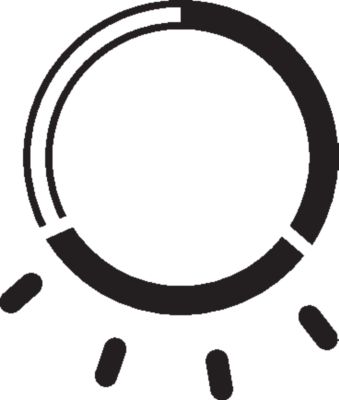
The progress indicator flashes in different patterns to indicate different performance modes and operations.
- Milk warming: During warming, the indicator flashes and fills gradually to show progress. When warming is complete, it changes to solid on for 1 hour (including warming time).
- Sterilization mode: During sterilization, the indicator flashes and fills gradually to show progress. When sterilization is complete, it turns off completely.
- Keep warm/defrost | Baby food warming: The entire indicator flashes continuously during warming/defrosting. When warming/defrosting is complete, the indicator changes to solid on for one hour (including warming time).
- No water: The entire indicator flashes rapidly and continues until the power button is pressed.
Alert sound
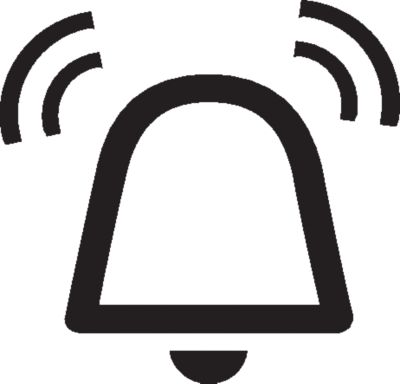
The appliance plays an alert sound to notify you of different statuses. It can be switched on and off as needed by following this video guide or using the directions below. The different alerts are as follows.
- Mode finished: Beeps 3 times when bottle warming, sterilization, the keep warm/defrost setting and baby food warming are complete.
- Sterilizing starts: Beeps 1 time.
- No water: Makes 1 long beep when the appliance runs out of water.
Turning off the alert sound
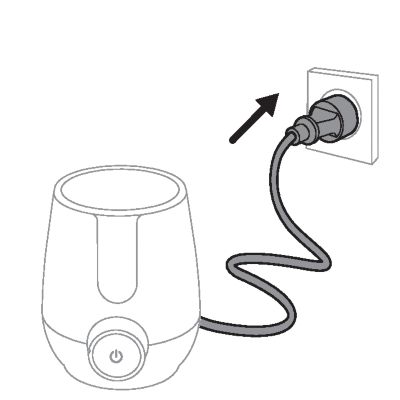
- Plug in the appliance.
-
- Select the keep warm/defrost setting.
-
- Press and hold the power button for 3 seconds.
-
- The appliance beeps once to show the alert sound is off.
Turning on the alert sound

- Plug in the appliance.
-
- Select the keep warm/defrost setting.
-
- Press and hold the power button for 3 seconds.
-
- The appliance beeps twice to show the alert sound is on.
Milk volume
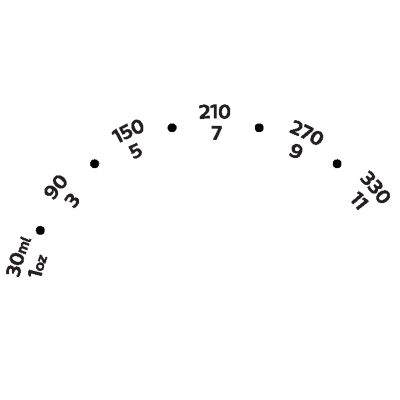
Select this setting for warming milk that is refrigerated or room temperature.
- The bottle warmer warms the milk to the desired temperature. Milk is ready for feeding when the appliance beeps 3 times and the entire progress indicator lights up. For warmer milk, leave the bottle in the appliance until it reaches the desired temperature.
- When warming is complete, the appliance automatically switches to the keep warm setting and keeps milk warm for up to 60 minutes (including warming time) or when the power button is pressed.
- Do not rewarm milk after is has cooled down to avoid encouraging bacteria growth.
Milk may feel cold to you, but most babies will accept milk that is colder than body temperature.
Sterilizing

Use this mode for sterilizing your bottles and baby items. A full cycle takes around 7 minutes.
Baby food warming
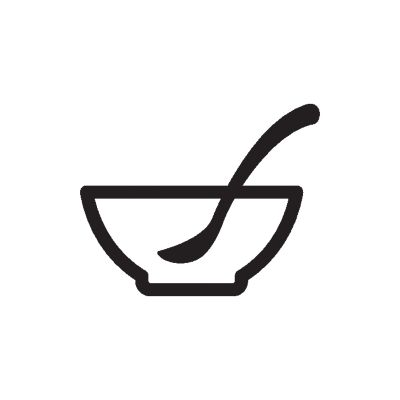
Select this setting for warming baby food.
Keep warm/defrost
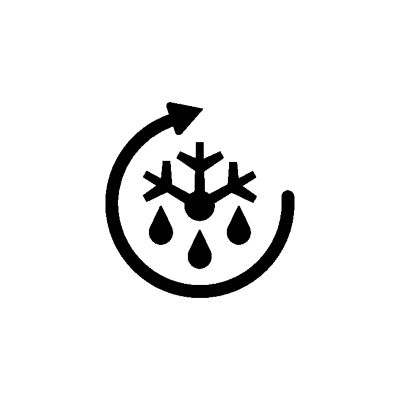
Use this setting for keeping milk warm and defrosting frozen milk and baby food.
- The built-in sensor adjusts the heating pattern.
- If milk or baby food is already warm, it is warmed gradually and kept at the required temperature.
- If milk is frozen, it will be defrosted until it becomes liquid and then warmed to the required temperature.
- If baby food is frozen, it is defrosted, then the appliance must be switched off and then back on, and the food must be warmed using baby food warming mode.
Read the following information carefully to make sure your milk bottles and storage containers are compatible with this product.
Compatible bottles and containers (warming)
- All Philips Avent milk bottles and baby food containers, and most commonly-used bottles and baby food containers from other major brands.
- Materials: plastic, glass, silicone, and milk storage bags.
- Check milk storage bag instructions to make sure they are safe for use.
- The max milk and food volumes supported for warming are as follows:
- Liquid milk: 30-330 ml/1-11 oz
- Frozen milk: 30-180 ml/1-6 oz
- Baby food: 30-180 ml/1-6 oz
- Liquid milk: 30-330 ml/1-11 oz
- Frozen milk: 30-180 ml/1-6 oz
- Baby food: 30-180 ml/1-6 oz
- Liquid milk: 30-330 ml/1-11 oz
- Frozen milk: 30-180 ml/1-6 oz
- Baby food: 30-180 ml/1-6 oz
Compatible bottles and containers (sterilization)
- Any milk bottle with with a height of 17 cm (6.7 in) or less.
- Any baby items that fit in the sterilization attachment and are safe for sterilization by steam.
- Check the instructions for your baby items to make sure they are safe for sterilization.
To quickly learn how to warm milk in plastic bottles, check out our helpful how-to video here.
You can also follow the directions below.
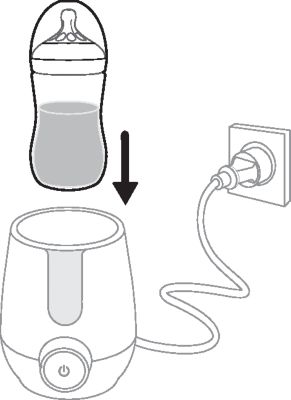
- Plug in the appliance and place the bottle inside.
- Add water:
- Only use room temperature water for accurate warming results.
- Use the window on the front of the appliance to check the water level.
-
- For small milk volumes, add water up to the level of the milk.
-
- For large milk volumes above the top of the base, fill up to 1 cm/0.4 in below the rim of the base.
-
- Select a setting based on the milk volume.
- Press the power button to start.
- The progress indicator flashes and fills gradually to show progress.
- When warming is complete, the appliance beeps 3 times and the progress indicator is solid on.
- The appliance changes to keep warm mode and switches off automatically after 60 minutes (including warming time).
- Before feeding your baby, take out the bottle and check whether the milk is at a safe temperature.
- Be careful of hot water when removing the bottle.
- Always check milk temperature before feeding your baby.
- Press the power button to switch off the appliance.
- Let the water cool down, then unplug the appliance and pour out the water sideways into the sink to avoid spilling on the knob or mains plug.
To quickly learn how to warm milk in glass and silicone bottles, check out our helpful how-to video here.
You can also follow the directions below.

- Plug in the appliance and place the bottle inside.
- Add water:
- Only use room temperature water for accurate warming results.
- Use the window on the front of the appliance to check the water level.
-
- For small milk volumes, add water up to the level of the milk.
-
- For large milk volumes above the top of the base, fill up to 1 cm/0.4 in below the rim of the base.
-
- Select a setting based on the milk volume.
- Glass bottles warm quickly. Use a lower setting. Check the table in the Recommmended settings by milk container type section for more info.
- Press the power button to start.
- The progress indicator flashes and fills gradually to show progress.
- When warming is complete, the appliance beeps 3 times and the progress indicator is solid on.
- The appliance changes to keep warm mode and switches off automatically after 60 minutes (including warming time).
- Continue warming silicone bottles for an additional 3-4 minutes for best results.
- Before feeding your baby, take out the bottle and check whether the milk is at a safe temperature.
- Be careful of hot water when removing the bottle.
- Always check milk temperature before feeding your baby.
- Press the power button to switch off the appliance.
- Let the water cool down, then unplug the appliance and pour out the water sideways into the sink to avoid spilling on the knob or mains plug.
To quickly learn how to warm milk in milk bags, check out our helpful how-to video here.
You can also follow the directions below.
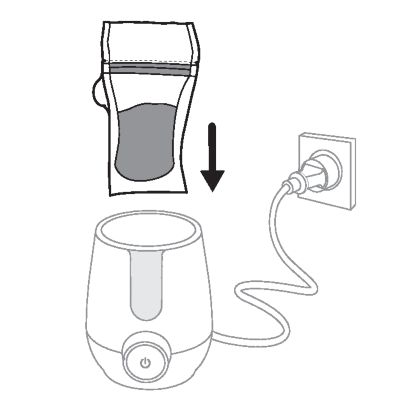
- Plug in the appliance and place the milk bag inside.
- Check your milk bag's instructions to make sure it is safe for warming.
- Add water:
- Only use room temperature water for accurate warming results.
- Use the window on the front of the appliance to check the water level.
-
- For small milk volumes, add water up to the level of the milk.
-
- For large milk volumes above the top of the base, fill up to 1 cm/0.4 in below the rim of the base.
-
- Select the keep warm/defrost setting.
- Using the keep warm/defrost setting is recommended, as milk bags warm more quickly.
- Press the power button to start.
- The full progress indicator flashes to show warming is in progress.
- When warming is complete, the appliance beeps 3 times and the progress indicator is solid on.
- The appliance changes to keep warm mode and switches off automatically after 60 minutes (including warming time).
- Take out the milk bag and pour the milk into a bottle.
- Be careful of hot water when removing the milk bag.
- Before feeding your baby, check whether the milk is at a safe temperature.
- Always check milk temperature before feeding your baby.
- Press the power button to switch off the appliance.
- Let the water cool down, then unplug the appliance and pour out the water sideways into the sink to avoid spilling on the knob or mains plug.
To quickly learn how to defrost and warm frozen milk, check out our helpful how-to video here.
You can also follow the directions below.
The keep warm/defrost setting is used for defrosting milk. For this setting, the appliance's built-in sensor detects the temperature of the container contents and adjusts the heating pattern between defrosting them or keeping them warm. When warming frozen milk, the bottle warmer defrosts the milk to a liquid state and then warms it to the desired temperature.
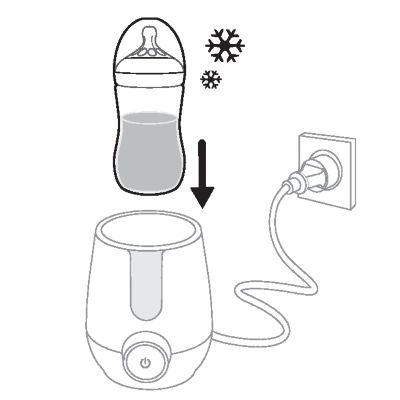
- Plug in the appliance and place the container with the frozen milk inside.
- Only use plastic milk bottles or milk bags for freezing milk. Glass bottles may break when defrosting.
- Add water:
- Only use room temperature water for accurate warming results.
- Use the window on the front of the appliance to check the water level.
-
- For small milk volumes, add water up to the level of the milk.
-
- For large milk volumes above the top of the base, fill up to 1 cm/0.4 in below the rim of the base.
-
- Select the keep warm/defrost setting.
- Press the power button to start.
- The full progress indicator flashes to show defrosting is in progress.
- Determining precise warming times for frozen milk is not possible due to variations in consistency.
- When warming is complete, the appliance beeps 3 times and the progress indicator is solid on.
- The appliance changes to keep warm mode and switches off automatically after 60 minutes (including warming time).
- Before feeding your baby, take out the milk and check whether it is at a safe temperature.
- Be careful of hot water when removing the bottle.
- Always check milk temperature before feeding your baby.
- Press the power button to switch off the appliance.
- Let the water cool down, then unplug the appliance and pour out the water sideways into the sink to avoid spilling on the knob or mains plug.
To quickly learn how to use the keep warm/defrost setting to keep milk warm, check out our helpful how-to video here.
You can also follow the directions below.
For this setting, the appliance's built-in sensor detects the temperature of the container contents and adjusts the heating pattern between defrosting them or keeping them warm. When using this setting for milk that has already been warmed, the milk is warmed gradually and kept at a consistent temperature.
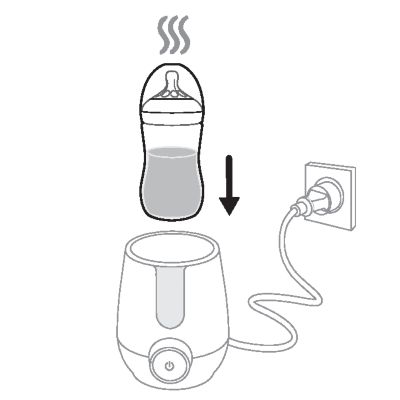
- Plug in the appliance and place the bottle inside.
- Add water:
- Only use room temperature water for accurate warming results.
- Use the window on the front of the appliance to check the water level.
-
- For small milk volumes, add water up to the level of the milk.
-
- For large milk volumes above the top of the base, fill up to 1 cm/0.4 in below the rim of the base.
-
- Select the keep warm/defrost setting.
- Press the power button to start.
- The full progress indicator flashes to show warming is in progress.
- When warming is complete, the appliance beeps 3 times and the progress indicator is solid on.
- The appliance continues keeping the milk warm using keep warm mode and switches off automatically after 60 minutes (including warming time).
- Before feeding your baby, take out the milk and check whether it is at a safe temperature.
- Be careful of hot water when removing the bottle.
- Always check milk temperature before feeding your baby.
- Press the power button to switch off the appliance.
Let the water cool down, then unplug the appliance and pour out the water sideways into the sink to avoid spilling on the knob or mains plug.
To quickly learn how to warm baby food, check out our helpful how-to video here.
You can also follow the directions below.
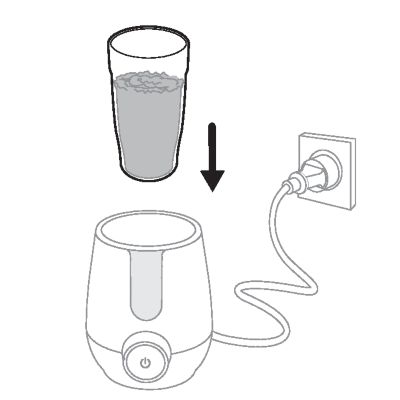
- Plug in the appliance and place the container with the baby food inside.
- Add water:
- Only use room temperature water for accurate warming results.
- Use the window on the front of the appliance to check the water level.
-
- For small food volumes, add water up to the level of the food.
-
- For large food volumes above the top of the base, fill up to 1 cm/0.4 in below the rim of the base.
-
- Select the baby food warming setting.
- Press the power button to start.
- The full progress indicator flashes to show warming is in progress. Stir the baby food to make sure it warms evenly.
- Determining precise baby food warming times is not possible due to variations in consistency.
- Be careful not to burn your hands by holding the food container while stirring. The container may be hot.
- When warming is complete, the appliance beeps 3 times and the progress indicator is solid on.
- The appliance changes to keep warm mode and switches off automatically after 60 minutes (including warming time).
- Take out the food and gently stir it, then test the temperature by tasting it to make sure it is safe for feeding your baby.
- Always check food temperature before feeding your baby.
- Press the power button to switch off the appliance.
- Let the water cool down, then unplug the appliance and pour out the water sideways into the sink to avoid spilling on the knob or mains plug.
To quickly learn how to defrost and warm frozen baby food, check out our helpful how-to video here.
You can also follow the directions below.
The keep warm/defrost setting is used to defrost baby food. For this setting, the appliance's built-in sensor detects the temperature of the container contents and adjusts the heating pattern between defrosting them or keeping them warm. For frozen baby food, this setting only defrosts the baby food, and then you must restart the appliance and use the baby food warming setting to warm the food to the desired temperature.
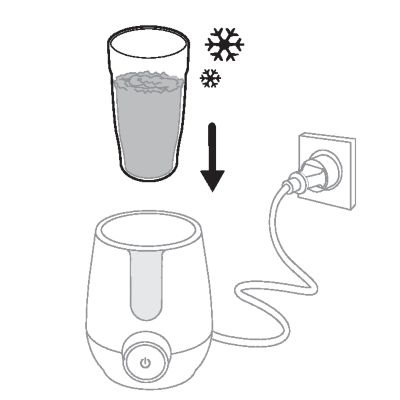
- Plug in the appliance and place the container with the frozen baby food inside.
- Only use plastic food containers for freezing baby food. Glass containers may break when defrosting.
- Add water:
- Only use room temperature water for accurate warming results.
- Use the window on the front of the appliance to check the water level.
-
- For small food volumes, add water up to the level of the food.
-
- For large food volumes above the top of the base, fill up to 1 cm/0.4 in below the rim of the base.
-
- Select the keep warm/defrost setting.
- Press the power button to start.
- The full progress indicator flashes to show warming is in progress.
- For reference, it takes around 60 minutes to defrost 180 ml/6 oz of frozen baby food. Total defrosting time may be longer or shorter depending on the amount of food and the container material.
- When warming is complete, the appliance beeps 3 times and the progress indicator is solid on.
- Press the power button to switch off the appliance.
- The appliance must be switched off and then back on before warming defrosted baby food or the baby food warming setting will not work.
- Select the baby food warming setting.
- Press the power button to start.
- The full progress indicator flashes to show warming is in progress. Stir the baby food to make sure it warms evenly.
- Determining precise baby food warming times is not possible due to variations in consistency.
- Be careful not to burn your hands by holding the food container while stirring. The container may be hot.
- When warming is complete, the appliance beeps 3 times and the progress indicator is solid on.
- The appliance changes to keep warm mode and switches off automatically after 60 minutes (including warming time).
- Take out the food and gently stir it, then test the temperature by tasting it to make sure it is safe for feeding your baby.
- Always check food temperature before feeding your baby.
- Press the power button to switch off the appliance.
- Let the water cool down, then unplug the appliance and pour out the water sideways into the sink to avoid spilling on the knob or mains plug.
To quickly learn how to sterilize your bottles and baby items, check out our helpful how-to video here.
You can also follow the directions below.
Check and make sure your bottles and baby items are safe for sterilization before getting started.
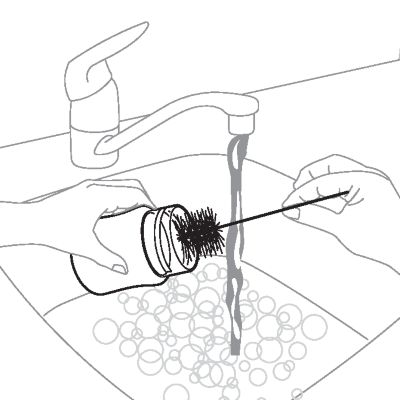
- Clean your bottles and baby items thoroughly with lukewarm water and mild detergent.
- Fill the base with water up to the marking (60 ml/2 oz).
- Note: This appliance has been designed to be used with tap water. If you live in an area with hard water, fast scale build-up may occur. Therefore, it is recommended to use distilled or demineralized water to prolong the lifetime of the appliance.
- Place a bottle or another large baby item in the base with the opening facing down.
- Do not place small or thin items in the base that can fit through the screen at the bottom to avoid damage and melting.
- Place the sterilization attachment on the base.
- Make sure your smaller items are fully disassembled, then place them in the top compartment of the sterilization attachment with their openings pointing down in the order shown: nipple > screw ring > pacifier/soother. You can also watch this helpful video for more tips.
- Place the lid on the sterilization attachment.
- Make sure the items don't prevent the lid from closing.
- Select the sterilizing setting.
- The base, sterilization attachment and lid become hot during or shortly after operation.
- Press the power button to start.
- The progress indicator flashes and fills gradually to show progress. The full sterilization cycle takes around 7 minutes.
- When sterilizing is complete, the appliance beeps three times and the progress indicator is solid on.
- Wait for the appliance to cool down before removing the lid.
- Be careful of hot surfaces and steam coming out of the appliance.
- Take out the sterilized items and place them on a clean towel or drying rack to air-dry.
- Wash your hands thoroughly before removing items from the sterilization attachment.
- Use tongs to remove small baby items from the top compartment.
Check the following tables to learn how long it may take to warm milk based on the milk volume and temperature.
Liquid milk warming times
| Setting | Room temperature milk (22 °C/72 °F) | Cold/refrigerated milk (5 °C/41 °F) |
| 30 ml/1 oz | 4:00-4:15 min | 4:00-4:15 min |
| 60 ml/2 oz | 2:45-3:30 min | 4:45-5:30 min |
| 90 ml/3 oz | 3:00-4:00 min | 5:00-6:00 min |
| 120 ml/4 oz | 3:00-4:00 min | 5:00-6:00 min |
| 150 ml/5 oz | 3:00-4:00 min\t | 5:00-6:00 min |
| 180 ml/6 oz | 3:30-4:30 min | 5:30-6:30 min |
| 210 ml/7 oz | 3:30-4:30 min | 5:30-6:30 min |
| 240 ml/8 oz | 5:00-6:00 min | 6:30-7:30 min |
| 270 ml/9 oz | 5:00-6:00 min | 6:30-7:30 min |
| 300 ml/10 oz | 5:15-6:15 min | 6:45-7:45 min |
| 330 ml/11 oz | 5:30-6:30 min | 7:00-8:00 min |
Frozen milk (-10 °C/14 °F in milk bag)
| Volume | Heating time |
| 30 ml/1 oz | 20-25 min |
| 60 ml/2 oz | 30-35 min |
| 90 ml/3 oz | 35-40 min |
| 120 ml/4 oz | 45-50 min |
| 150 m/5 oz | 50-55 min |
| 180 ml/6 oz | 60-65 min |
When using the appliance to warm milk bags, always use the keep warm/defrost setting.
Check the following table for recommended milk warming settings based on your container type.
| Milk container | Milk starting temperature | Milk volume | Recommended setting |
| Glass | 22 °C/72 °F | 1-3 oz/30-90 ml | 1 oz/30 ml |
| 4-6 oz/120-180 ml | 2 oz/60 ml | ||
| 7-8 oz/210-240 ml | 4 oz/120 ml | ||
| 5 °C/40 °F | 1 oz/30 ml | 1 oz/30 ml | |
| 2-6 oz/60-180 ml | 2 oz/60 ml | ||
| 7-8 oz/210-240 ml | 4 oz/120 ml | ||
| Plastic | 22 °C/72 °F or 5 °C/40 °F | 1-11 oz/30-330 ml | Milk volume setting |
| Silicone | 22 °C/72 °F or 5 °C/40 °F | 1-9 oz/30-270 ml | Milk volume setting + 3-4 min |
| Milk storage bag | 22 °C/72 °F or 5 °C/40 °F | 1-6 oz/30-180 ml | Keep warm/defrost setting |
To quickly learn how to properly clean and descale the appliance, check out our helpful how-to video here.
You can also follow the directions below.
Descale the appliance every 2 weeks to ensure it works effectively.
Cleaning
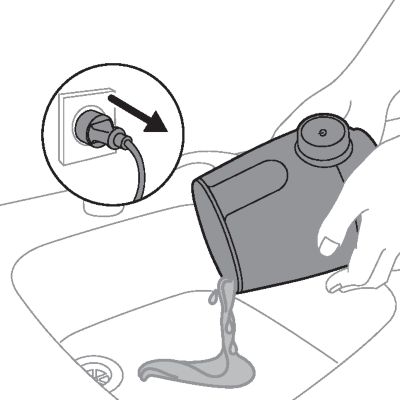
- Unplug the appliance, let it cool down, and then pour the water out sideways into the sink to avoid spilling on the knob or mains plug.
- Wipe the appliance with a damp cloth.
- Do not use abrasive, antibacterial cleaning agents, chemical solvents or sharp tools to clean the appliance.
- Clean the sterilizer attachment by hand washing or in the dishwasher.
Descaling
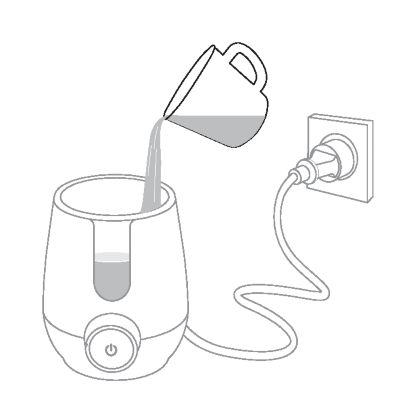
- Plug in the appliance and add a mixture of 60 ml/2 oz of white vinegar (5% acetic acid) and 120 ml/4 oz of water.
- Mix the water and vinegar separately before pouring it into the base.
- Select 180 ml/6 oz.
- Press the power button to start.
- The appliance beeps three times when the descaling solution reaches the correct temperature.
- Leave the descaling solution in the appliance until it switches off automatically after 60 minutes.
- Pour out the descaling solution sideways into the sink to avoid spilling on the knob and mains plug.
- Rinse out the appliance.
- Use a towel or cloth to wipe any remaining moisture off the appliance and let it air-dry completely before storage.
This Philips appliance complies with all applicable standards and regulations regarding exposure to electromagnetic fields.
To buy accessories or spare parts, visit www.philips.com/support or go to your Philips dealer. You can also contact the Philips Consumer Care Center in your country.
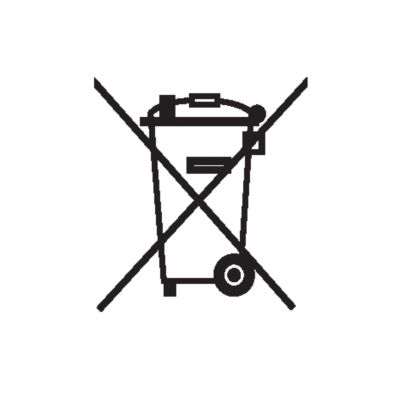
- This symbol means that electrical products shall not be disposed of with normal household waste.
- Follow your country's rules for the separate collection of electrical products.
For all product support, power consumption details and the EU Declaration of Conformity, please visit www.philips.com/support.
Note: This appliance needs to be descaled regularly for optimal performance. If you do not do this, the appliance may eventually stop working. In this case, repair is NOT covered by your warranty.
